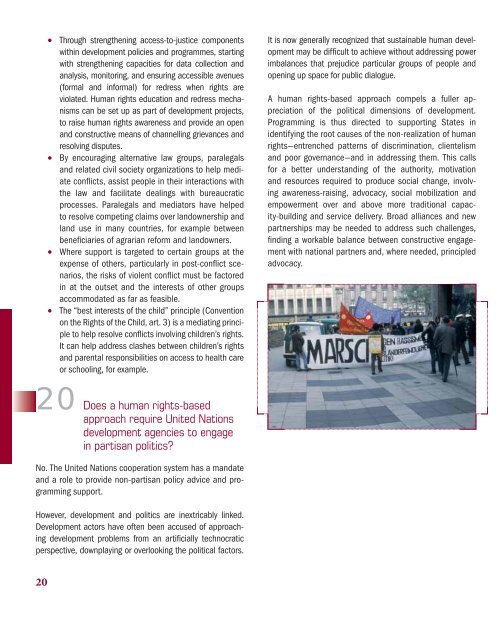systems, a human rights-based approach can greatly reinforceprogress towards gender equality.Gender mainstreaming and a human rights-based approachto development have much in comm<strong>on</strong>. Both rely<strong>on</strong> an analytical framework that can be applied to alldevelopment activities (for the former, the different situati<strong>on</strong>experienced and roles played by men and women ina given society; and for the latter, a normative frameworkbased <strong>on</strong> entitlements and obligati<strong>on</strong>s). Both call attenti<strong>on</strong>to the impact of activities <strong>on</strong> the welfare of specificgroups, as well as to the importance of empowerment andparticipati<strong>on</strong> in decisi<strong>on</strong>-making. Both apply to all stagesof activity (design, implementati<strong>on</strong>, m<strong>on</strong>itoring and evaluati<strong>on</strong>)and to all types of acti<strong>on</strong> (legislati<strong>on</strong>, policies andprogrammes). Finally, both require the systematic adopti<strong>on</strong>of new and different approaches to existing activities,as distinct from developing new and additi<strong>on</strong>al activities.In most organizati<strong>on</strong>s, gender mainstreaming is a more familiarc<strong>on</strong>cept than human rights mainstreaming. Structuresand processes set up to ensure gender mainstreaming can beemulated or adapted to facilitate the introducti<strong>on</strong> of a humanrights-based approach to programming more generally. But,equally, there is a need to learn from situati<strong>on</strong>s where gendermainstreaming has failed. If staff perceive mainstreaminggender (or human rights) as a bureaucratic or technicalrequirement without real implicati<strong>on</strong>s for their own work, andif internal incentive structures are weak and lines of accountabilityunclear, the approach may have no impact.19 Can a human rights-based approachhelp to resolve c<strong>on</strong>flicts betweendifferent stakeholders in development?Yes. While development is not a zero-sum game, all entitlementscannot be realized for all people at <strong>on</strong>ce. Clashesof interest are inevitable, and development actors can profoundlyinfluence the pattern of winners and losers nati<strong>on</strong>ally.C<strong>on</strong>flicts swept under the carpet and grievances ignoredcan be recipes for violent c<strong>on</strong>fr<strong>on</strong>tati<strong>on</strong>. C<strong>on</strong>versely, andmore positively, n<strong>on</strong>-violent c<strong>on</strong>flict can help create spacefor dialogue and generate impetus for social change.<strong>Human</strong> rights: a framework to resolve c<strong>on</strong>flictover competing claims for shared resourcesThe World Commissi<strong>on</strong> <strong>on</strong> Dams was an independent bodysp<strong>on</strong>sored by the World Bank to review the performance of largedams and make recommendati<strong>on</strong>s for future planning of waterand energy projects. In 2000, after two years of investigati<strong>on</strong> intodam development projects, it released a final report, Dams anddevelopment: A new framework for decisi<strong>on</strong>-making. The reportstated that, given the significance of rights-related issues aswell as the nature and magnitude of potential risks for all partiesc<strong>on</strong>cerned, human rights should be the fundamental referencepoint in all initiatives c<strong>on</strong>cerning dams.The World Commissi<strong>on</strong> <strong>on</strong> Dams held that, in the future, not <strong>on</strong>lydams but the entire development debate would require a rightsbasedapproach where recogniti<strong>on</strong> of rights and assessment ofrisks would provide the basis for negotiated decisi<strong>on</strong>s <strong>on</strong> damsand their alternatives. That rights-based approach, accordingto the World Commissi<strong>on</strong> <strong>on</strong> Dams, should include a processto assess reparati<strong>on</strong>s and envir<strong>on</strong>mental restorati<strong>on</strong> as well asdevelopment of plans for sharing the benefits.With human rights in mind, development programmes andactors can help to address and manage c<strong>on</strong>flict, for instance:For further informati<strong>on</strong> <strong>on</strong> the World Commissi<strong>on</strong> <strong>on</strong> Dams,see http://www.dams.org//docs/overview/wcd_overview.pdf.By undertaking social impact assessments and riskanalysis prior to any significant development policyinitiative or programme, with provisi<strong>on</strong> for participatorym<strong>on</strong>itoring throughout.19
Through strengthening access-to-justice comp<strong>on</strong>entswithin development policies and programmes, startingwith strengthening capacities for data collecti<strong>on</strong> andanalysis, m<strong>on</strong>itoring, and ensuring accessible avenues(formal and informal) for redress when rights areviolated. <strong>Human</strong> rights educati<strong>on</strong> and redress mechanismscan be set up as part of development projects,to raise human rights awareness and provide an openand c<strong>on</strong>structive means of channelling grievances andresolving disputes.By encouraging alternative law groups, paralegalsand related civil society organizati<strong>on</strong>s to help mediatec<strong>on</strong>flicts, assist people in their interacti<strong>on</strong>s withthe law and facilitate dealings with bureaucraticprocesses. Paralegals and mediators have helpedto resolve competing claims over landownership andland use in many countries, for example betweenbeneficiaries of agrarian reform and landowners.Where support is targeted to certain groups at theexpense of others, particularly in post-c<strong>on</strong>flict scenarios,the risks of violent c<strong>on</strong>flict must be factoredin at the outset and the interests of other groupsaccommodated as far as feasible.The “best interests of the child” principle (C<strong>on</strong>venti<strong>on</strong><strong>on</strong> the <strong>Rights</strong> of the Child, art. 3) is a mediating principleto help resolve c<strong>on</strong>flicts involving children’s rights.It can help address clashes between children’s rightsand parental resp<strong>on</strong>sibilities <strong>on</strong> access to health careor schooling, for example.It is now generally recognized that sustainable human developmentmay be difficult to achieve without addressing powerimbalances that prejudice particular groups of people andopening up space for public dialogue.A human rights-based approach compels a fuller appreciati<strong>on</strong>of the political dimensi<strong>on</strong>s of development.Programming is thus directed to supporting States inidentifying the root causes of the n<strong>on</strong>-realizati<strong>on</strong> of humanrights—entrenched patterns of discriminati<strong>on</strong>, clientelismand poor governance—and in addressing them. This callsfor a better understanding of the authority, motivati<strong>on</strong>and resources required to produce social change, involvingawareness-raising, advocacy, social mobilizati<strong>on</strong> andempowerment over and above more traditi<strong>on</strong>al capacity-buildingand service delivery. Broad alliances and newpartnerships may be needed to address such challenges,finding a workable balance between c<strong>on</strong>structive engagementwith nati<strong>on</strong>al partners and, where needed, principledadvocacy.20 Does a human rights-basedapproach require United Nati<strong>on</strong>sdevelopment agencies to engagein partisan politics?No. The United Nati<strong>on</strong>s cooperati<strong>on</strong> system has a mandateand a role to provide n<strong>on</strong>-partisan policy advice and programmingsupport.However, development and politics are inextricably linked.Development actors have often been accused of approachingdevelopment problems from an artificially technocraticperspective, downplaying or overlooking the political factors.20
















